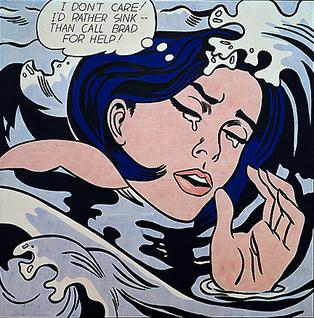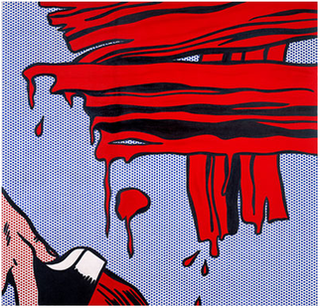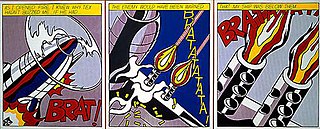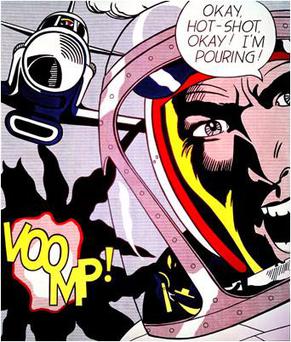
Roy Fox Lichtenstein was an American pop artist. During the 1960s, along with Andy Warhol, Jasper Johns, and James Rosenquist, he became a leading figure in the new art movement. His work defined the premise of pop art through parody. Inspired by the comic strip, Lichtenstein produced precise compositions that documented while they parodied, often in a tongue-in-cheek manner. His work was influenced by popular advertising and the comic book style. His artwork was considered to be "disruptive". He described pop art as "not 'American' painting but actually industrial painting". His paintings were exhibited at the Leo Castelli Gallery in New York City.

Louise Lawler is a U.S. artist and photographer living in Brooklyn, New York. From the late 1970s onwards, Lawler’s work has focused on photographing portraits of other artists’ work, giving special attention to the spaces in which they are placed and methods used to make them. Examples of Lawler's photographs include images of paintings hanging on the walls of a museum, paintings on the walls of an art collector's opulent home, artwork in the process of being installed in a gallery, and sculptures in a gallery being viewed by spectators.

Whaam! is a 1963 diptych painting by the American artist Roy Lichtenstein. It is one of the best-known works of pop art, and among Lichtenstein's most important paintings. Whaam! was first exhibited at the Leo Castelli Gallery in New York City in 1963, and purchased by the Tate Gallery, London, in 1966. It has been on permanent display at Tate Modern since 2006.

Torpedo...Los! is a 1963 pop art oil on canvas painting by Roy Lichtenstein. When it was last sold in 1989, The New York Times described the work as "a comic-strip image of sea warfare". It formerly held the record for the highest auction price for a Lichtenstein work. Its 1989 sale helped finance the construction of the current home of the Museum of Contemporary Art, Chicago in 1991.

Look Mickey is a 1961 oil on canvas painting by Roy Lichtenstein. Widely regarded as the bridge between his abstract expressionism and pop art works, it is notable for its ironic humor and aesthetic value as well as being the first example of the artist's employment of Ben-Day dots, speech balloons and comic imagery as a source for a painting. The painting was bequeathed to the Washington, D.C., National Gallery of Art upon Lichtenstein's death.

Drowning Girl is a 1963 American painting in oil and synthetic polymer paint on canvas by Roy Lichtenstein, based on original art by Tony Abruzzo. The painting is considered among Lichtenstein's most significant works, perhaps on a par with his acclaimed 1963 diptych Whaam!. One of the most representative paintings of the pop art movement, Drowning Girl was acquired by the Museum of Modern Art in 1971.

Brushstrokes series is the name for a series of paintings produced in 1965-1966 by Roy Lichtenstein. It also refers to derivative sculptural representations of these paintings that were first made in the 1980s. In the series, the theme is art as a subject, but rather than reproduce masterpieces as he had starting in 1962, Lichtenstein depicted the gestural expressions of the painting brushstroke itself. The works in this series are linked to those produced by artists who use the gestural painting style of abstract expressionism made famous by Jackson Pollock, but differ from them due to their mechanically produced appearance. The series is considered a satire or parody of gestural painting by both Lichtenstein and his critics. After 1966, Lichtenstein incorporated this series into later motifs and themes of his work.

Artist's Studio—Look Mickey is a 1973 painting by Roy Lichtenstein. It is one of five large-scale studio interior paintings in a series. The series is either referred to as the Artist's Studio series or more colloquially as the Studios and sometimes is described as excluding the other 1973 painting, reducing the series to four.

As I Opened Fire is a 1964 oil and magna on canvas painting by Roy Lichtenstein. The work is hosted at the Stedelijk Museum in Amsterdam. The source of the subject matter is Jerry Grandenetti's panels from "Wingmate of Doom," in All American Men of War, no. 90, DC Comics.

Golf Ball is a 1962 painting by Roy Lichtenstein. It is considered to fall within the art movement known as pop art. It depicts "a single sphere with patterned, variously directional semi-circular grooves." The work is commonly associated with black-and-white Piet Mondrian works. It is one of the works that was presented at Lichtenstein's first solo exhibition and one that was critical to his early association with pop art. The work is commonly critiqued for its tension involving a three-dimensional representation in two dimensions with much discussion revolving around the choice of a background nearly without any perspective.

Sleeping Girl is a 1964 oil and Magna on canvas pop art painting by Roy Lichtenstein. It held the record for the highest auction price for a Lichtenstein painting from May 2012 until May 2013.

Ohhh...Alright... is a 1964 pop art painting by Roy Lichtenstein. It formerly held the record for highest auction price for a Lichtenstein painting.

In the Car is a 1963 pop art painting by Roy Lichtenstein. The smaller, older of the two versions of this painting formerly held the record for highest auction price for a Lichtenstein painting. The larger version has been in the collection of the Scottish National Gallery of Modern Art in Edinburgh since 1980.

Happy Tears is a 1964 pop art painting by Roy Lichtenstein. It formerly held the record for highest auction price for a Lichtenstein painting.

Woman with Flowered Hat is a 1963 pop art painting with Magna on canvas by Roy Lichtenstein. The work is based on a Pablo Picasso portrait of Dora Maar. In May 2013, it sold for a record price for a Lichtenstein work.

Okay Hot-Shot, Okay! is a 1963 pop art painting by Roy Lichtenstein that uses his Ben-Day dots style and a text balloon. It is one of several examples of military art that Lichtenstein created between 1962 and 1964, including several with aeronautical themes like this one. It was inspired by panels from four different comic books that provide the sources for the plane, the pilot, the text balloon and the graphic onomatopoeia, "VOOMP!".

Bratatat! is a 1963 pop art painting by Roy Lichtenstein in his comic book style of using Ben-Day dots and a text balloon.

Brattata is a 1962 pop art painting by Roy Lichtenstein in his comic book style of using Ben-Day dots and a text balloon. The work is held in the collection at the Tehran Museum of Contemporary Art. It is one of several Lichtenstein works from All-American Men of War issue #89, but is a reworking of its source panel.

Jet Pilot is a 1962 pop art work done in graphite pencil by Roy Lichtenstein. Like many of Lichtenstein's works from this time period, it was inspired by a comic book image, but he made notable modifications of the source in his work.

Crak! is a 1963 pop art lithograph by Roy Lichtenstein in his comic book style of using Ben-Day dots and a text balloon. It was used in marketing materials for one of Lichtenstein's early shows. It is one of several of his works related to military art and monocular vision.





















